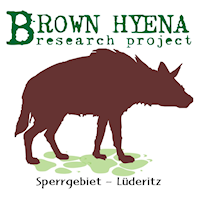Brown hyenas are one of Africa's large carnivores. They occur in the southern African sub-region: Angola, Zimbabwe, Botswana, Mozambique, Republic of South Africa and Namibia. In Namibia they are found throughout the entire country except in the north, north-eastern and south-eastern parts. The total population size of brown hyenas is estimated to be between 5000 and 8000 animals, which make them one of the rarest large African carnivores.
The brown hyena's current conservation status in Namibia is "insufficiently known (vulnerable or endangered)". Namibian authorities consider the species to be extremely vulnerable in Namibia and it is likely to become endangered if present declining population trends continue. In Namibia 800 to 1200 brown hyenas occur and the coastal areas of the Namib Desert are of major importance, as this area is inhabited by approximately 50% of the total Namibian population. There are only six conservation areas with governmental or private protection status within the brown hyena's distribution range, where viable brown hyena populations occur; one of them is the coastal region of the southern Namib Desert within the Sperrgebiet National Park. Like the spotted hyena, brown hyenas show the typical body proportions of strong muscular neck and shoulders and less strong developed hind legs. Due to their long fur cover this shape is hardly seen, unless in movement. Namib Brown hyenas weigh between 35 and 45 kg, with the males being slightly heavier than females.

Brown hyenas live in groups, called clans. Most members of a clan are related and usually only one female gives birth at a time to a litter of 1 to 4 cubs. Cubs are raised in dens, which are also the social meeting point of the clan. All members bring food back to the den in order to provide the cubs with additional food. Brown hyenas spend a lot of time at the dens, playing and socialising with the cubs, which helps the cubs to learn social behaviour. It takes 15 months for them to be fully weaned and before they are ready to leave the den.
Other than at dens, brown hyenas are usually seen on their own, while searching for food. They cover vast areas and it is not uncommon for them to travel as far as 40 km in a single night. They eat nearly everything they can find, from fruit and insects to mammals. Brown hyenas seldom hunt small or medium-sized mammals and usually rely on carcasses of animals, which died naturally or were killed by other predators.
At the Namib Desert Coast, brown hyenas are the only large predators and their only competitors are black-backed jackals. Prey density is generally low and therefore they can't rely on regular meals found as carcasses. However carrion, such as seabirds or Cape fur seals, is washed up along the entire Namibian coastline and serves as an important food source.
Nevertheless, brown hyena density along the Namib Desert coast is high and to maintain their population size, mainland Cape fur seal breeding colonies are of major importance. Brown hyenas visit these colonies on their foraging trips to feed on fresh carcasses or to kill seal pups. This food source is available during the entire year since seal pups are only weaned shortly before the next pup is born. Periods of food shortage are therefore seldom and brown hyenas here are in an especially good condition.
